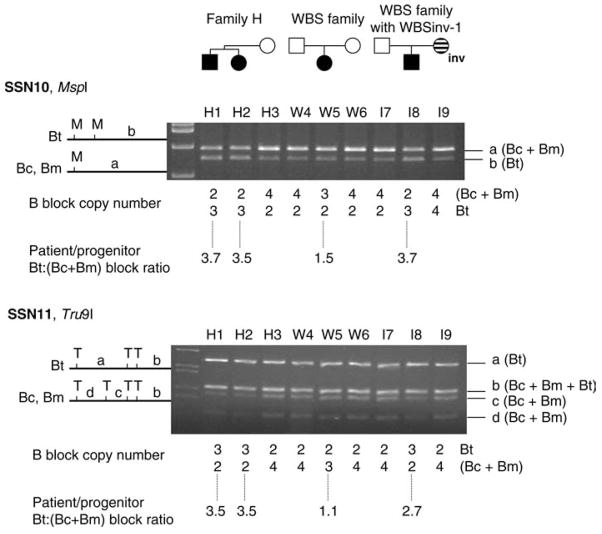Fig. 1.
SSN analysis of WBS families. SSN analysis of samples from family H, a WBS family without WBSinv-1, and a WBS family where the WBS deletion arose on a WBSinv-1 progenitor chromosome. Relative block dosages calculated from band intensities are depicted below each lane. Representative results for the SSN10 and SSN11 assays, which allow the detection of the WBSinv-1 in patients with WBS, are shown. Details of these assays are presented in Table 1 and in the main text. SSN10: As represented in the scheme, a nucleotide change in block Bt introduces an MspI site that is not present in blocks Bc and Bm. The WBS family proband (W5) shows two digested copies of fragment b (block Bt) versus three undigested copies of fragment a (blocks Bc and Bm), as shown below the gel. The WBSinv-1 proband, however (I8), shows a reduction of the intensity of fragment a (Bc+Bm) to two copies and an increase of the intensity of fragment b (Bt) to three copies. A ratio of the patient to progenitor B blocks is calculated from these copy numbers using the following equation: patient Bt:(Bc+Bm) ratio/progenitor Bt:(Bc+Bm) ratio, as previously described in Bayes et al. 2003. These ratios are shown at the bottom of the figure. A patient/progenitor block B ratio of approximately 3 indicates that in the WBSinv-1 proband I8, the WBS chromosome arose in a progenitor heterozygous for the inversion, I9. SSN11: As represented in the scheme, a nucleotide change in block Bt destroys a Tru9I site that is present in blocks Bc and Bm. The WBS family proband (W5) shows three digested copies of fragments corresponding to blocks Bc and Bm, versus two undigested copies of fragments corresponding to block Bt. The WBSinv-1 proband, however (I8), shows a reduction of the intensity of fragments c and d (Bc+Bm) and an increase of the intensity of fragment a (Bt). The patient/progenitor block B ratio of approximately 3 indicates that in the WBSinv-1 family proband I8, the WBS chromosome arose in a progenitor heterozygous for the inversion, I9. Dosage calculations in family H show that the two WBS siblings (H1 and H2) have patient/progenitor block B ratios of 3 for both SSN10 and SSN11, indicating that their deletions both arose in a progenitor heterozygous for WBSinv-1

